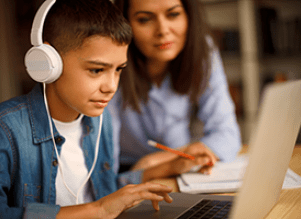4/20/2020
Switching to Remote Learning? Don’t Leave Equity Behind
In school districts across the United States, the COVID-19 outbreak has pushed teaching and learning from the classroom to the computer practically overnight.
Although some institutions—such as New York City's Success Academy charter school chain—were able to immediately switch to a remote learning, a number of public school districts across the country have struggled to do the same. Indeed, making the jump from in-person instruction to online lessons has been far from simple for many institutions.
A focus on flexibility
According to Taylor Swaak of education news outlet The 74 Million, Success Academy has 18,000 students in grades K-12, predominantly serves low-income students of color, and is the city's largest charter network. Needless to say, suddenly adapting classroom practices to an online-only model was no small feat. But rather than getting bogged down in the details, Success Academy Director Eva Moskowitz and her staff decided to focus on “minimalism and flexibility” to facilitate the logistical aspects of the switch.
In addition to navigating the logistical challenges associated with quick adoption of a remote learning model, schools in New York City and beyond are contending with the fact that many of the nation's students either lack appropriate devices for remote learning or do not have solid access to Wi-Fi. To that end, Jessica Sie, Success Academy's director of literacy and history, recommended downloading information onto a remote device and completing work on paper.
However, educators still have much to consider, such as how to go about accommodating students with a lower socio-economic status (SES), English language learners, and individuals with special education needs.
Ultimately, the question facing schools is not just how to rapidly implement online learning, but how to do so equitably.
Accessibility is paramount
In times of great uncertainty, it's hard to overstate the value of having a comprehensive guide to look toward. Thus, the Education Trust - New York, a policy and advocacy group affiliated with the national Education Trust nonprofit, quickly pulled together a guide for schools on how to prioritize educational equity during the COVID-19 pandemic.
According to the guide, “Preparing for the coronavirus through an educational equity lens starts by recognizing that vulnerable students are at particular risk if schools close for any length of time.” The first step of this process is to understand that any remote learning plan must be built around ensuring all students can access what they need to participate—including digital devices.
“Schools should not rely on remote or distance learning unless the school district has previously provided all students with access to required materials, including technology,” warned Education Trust - New York. In other words, it cannot be assumed that all families have enough (or any) computers to support a sudden shift to online instruction.
In their responses to a recent survey conducted by the online news site Education Week, nearly half of district and IT leaders reported feeling unprepared to offer remote learning “for even one day”—and beyond the lack of devices, an array of other challenges may interfere with school districts' efforts to create equitable remote learning plans. More specifically, Education Week's David Saleh Rauf identified the following road blocks:
-
Broadband access: Students in rural communities and other areas that may not have reliable Wi-Fi service often rely on schools and libraries. With these resources shut down, accessing the internet has become considerably harder.
-
Lack of guidance: Teachers, families, and districts have found themselves scrambling to adapt to an unprecedented situation for which there is no real blueprint. In lieu of existing remote learning frameworks, some districts have been forced to think outside the box by outfitting school buses with internet service and joining forces with public television stations to broadcast lessons.
-
Scaling up. Even for tech-savvy districts, coming up with enough Chromebooks and Wi-Fi hotspots at short notice has proven difficult.
As explained in a recent Chalkbeat article, some superintendents have dealt with issues such as inadequate device numbers and unreliable internet service by sidestepping online instruction altogether. According to Chalkbeat contributor Koby Levin, one teacher in a rural Michigan school district has been relying on offline homework assignments and enrichment packets to ensure all of his students can continue preparing for an upcoming, high-stakes AP chemistry exam; elsewhere in the state, students in a wealthy Detroit suburb “are completing the requirements of a full school day at home” thanks to their widespread ability to access necessary resources.
The bottom line
Given the widespread variation that exists among school districts with regard to online connectivity, device availability, and individual student needs, it is difficult to pinpoint a one-size-fits-all approach to equitable remote learning—particularly at short notice. While many administrators are understandably focused on rolling out a remote learning plan sooner rather than later, it is important to remember many states have policies in place that prohibit work from being either assigned or graded unless all students can equitably complete it.
Whether you are returning to a physical school or a remote classroom, consider including Lexia as a multi-year literacy solution for continuity of learning to boost teacher confidence and student outcomes at your school. To learn more, contact your Lexia rep.
 Listen Now »
Listen Now »

